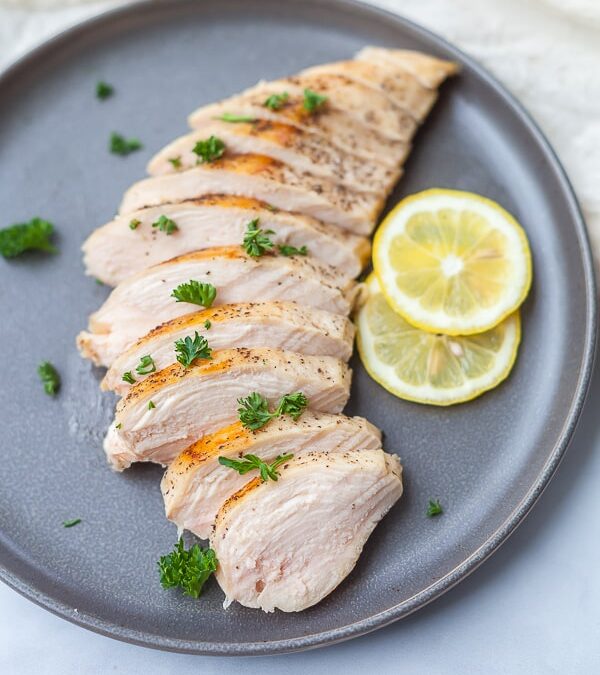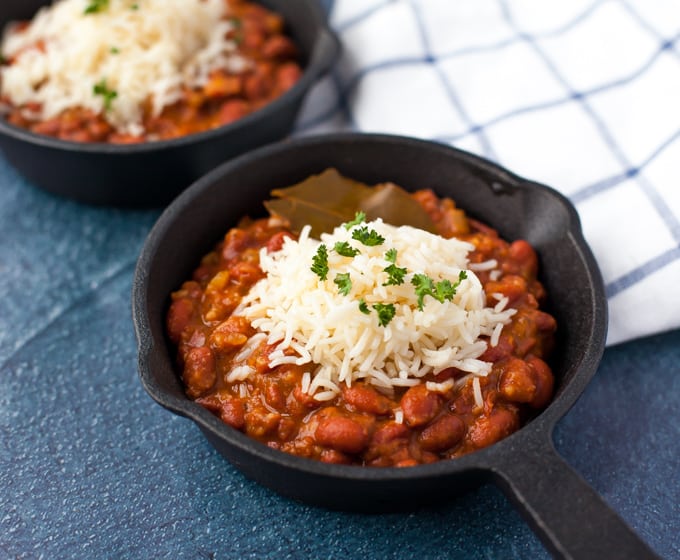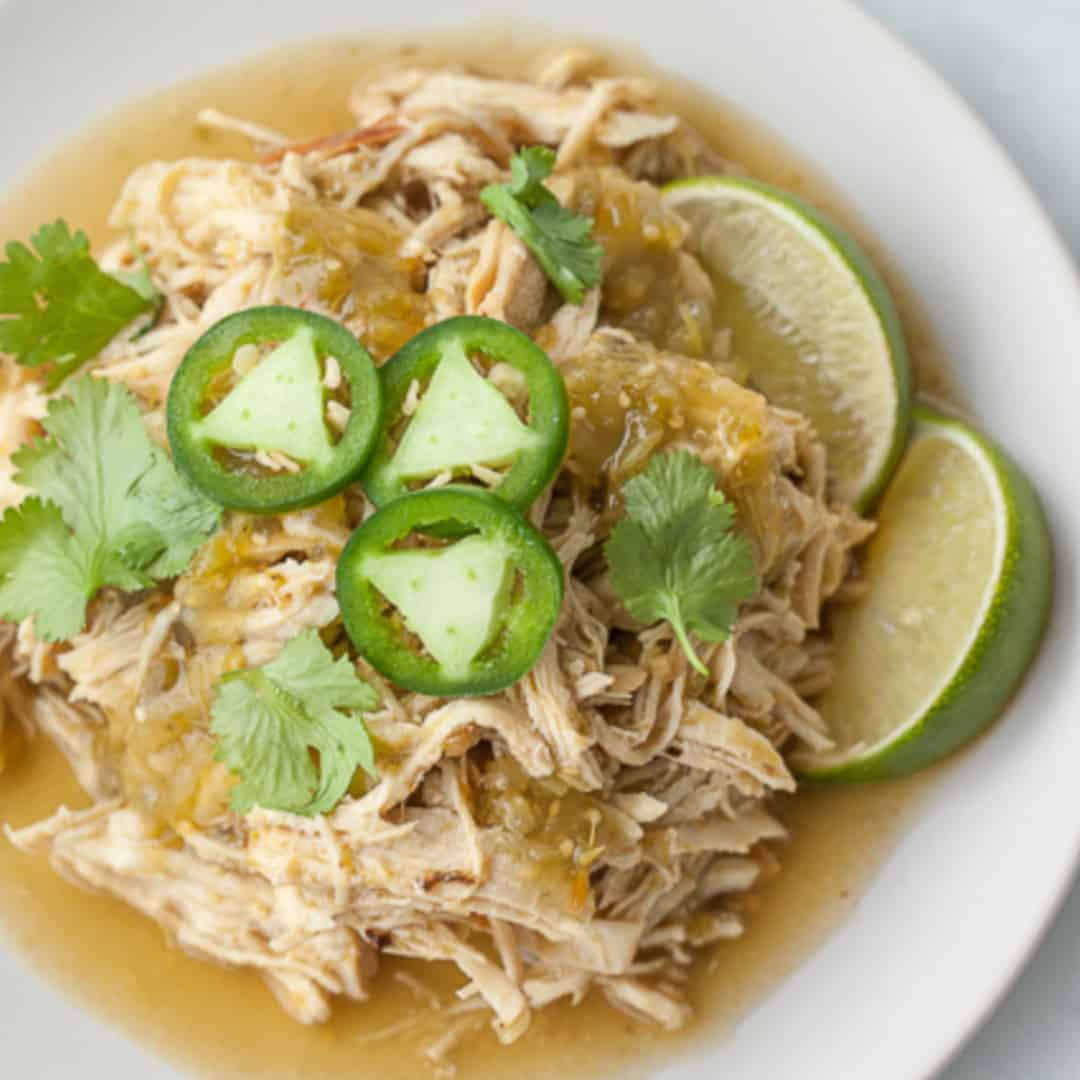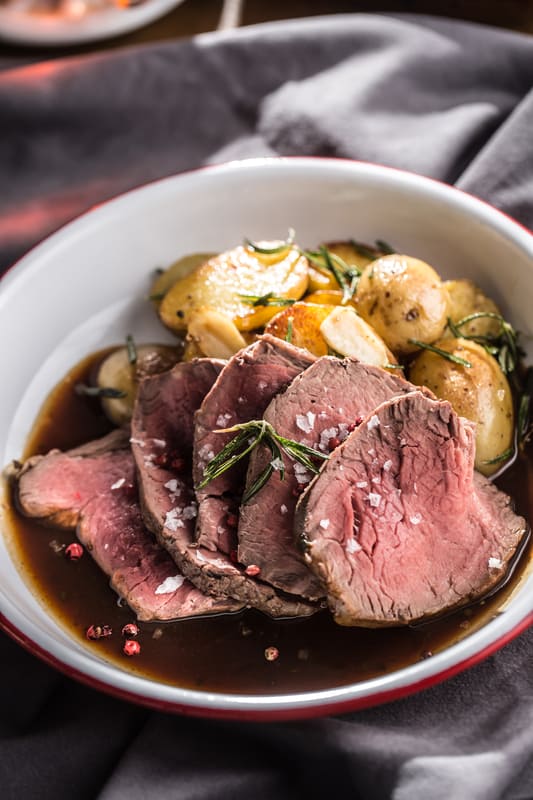Sous Vide Pork Tenderloin
Worried about pork tenderloin being too dry? It’s nearly impossible if you’re using the sous vide method. This Sous Vide Pork Tenderloin recipe is my go-to when I need a high protein dinner that’s budget friendly and can be seasoned in so many different ways!
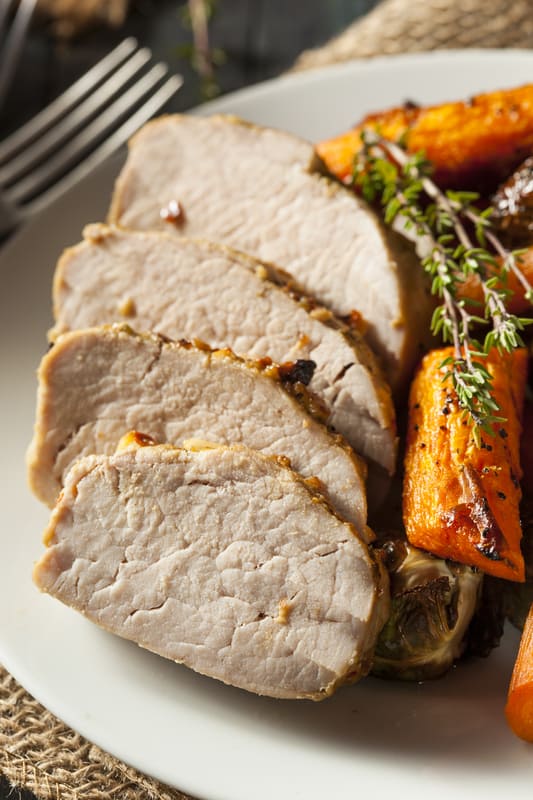
The other day I was filming for my Tiktok and Youtube a quick tutorial about how to make pork tenderloin sous vide. I went to link to this post but it didn’t exist! I have recipes for sous vide pork burgers, sous vide pork chops, and sous vide pulled pork.
How could I not include pork tenderloin in the mix!? Lets change that today.
The sous vide method uses a temperature controlled water bath to cook food at an EXACT temperature to make sure it cooks and stays exactly how you want it. While its known for mostly cooking steak, you can also use it to cook carrots, mashed potatoes, or even use it to chill beer!
Pork tenderloin is one of the BEST candidates for sous vide cooking because its a very lean protein that can easily dry out if its not cooked properly. This budget friendly protein also pairs well with so many different side dishes and can be seasoned in millions of different ways!
🐖Grab These Before You Make It
- Immersion Circulator
- Freezer Safe Bags (if you don’t have a vacuum sealer)
- Cambro for water bath (or use a large pot!)
- Pork Tenderloin
- Seasonings: Lemon Pepper, Cajun, Italian Seasoning, Garlic Butter, Taco Seasoning, Smoked Paprika . . . whatever fits the meal!
🌡️Choose Your Temperature
The best time and temperature to sous vide pork tenderloin depends on how you like your meat cooked. Generally, a safe internal temperature for pork is 145F. However, since it will be cooking for at least two hours, this will guarantee the meat gets pasteurized which means you can cook it fully at a lower temperature without worrying about bacteria.
| Temperature | Time | Result |
|---|---|---|
| 130°F (54°C) | 2 to 4 hours | Very juicy, tender, and slightly pink inside |
| 140°F (60°C) | 2 to 4 hours | Slightly firmer texture, still juicy, medium doneness |
| 150°F (66°C) | 2 to 4 hours | Fully cooked, firmer texture, no pink, traditional doneness |
🐖How To Sous Vide Pork Tenderloin
1️⃣Prepare the Water Bath: Fill a large pot or Cambro with water. Attach your immersion circulator and set it to your desired cooking temperature (130°F, 140°F, or 150°F, depending on your preference). Allow the water to reach the set temperature.
2️⃣Season the Pork Tenderloin: Pat the pork tenderloin dry with paper towels. Generously season it with your chosen seasoning.
3️⃣Seal the Pork
- Vacuum Sealing Method: Place the seasoned pork tenderloin in a vacuum-sealable bag and use a vacuum sealer to remove the air and seal the bag.
- Water Displacement Method: If you don’t have a vacuum sealer, place the seasoned pork tenderloin in a freezer-safe Ziplock bag. Slowly lower the bag into the water bath, letting the water push the air out of the bag, then seal the bag just above the waterline.
4️⃣Cook in the Water Bath: Submerge the sealed bag with the pork tenderloin into the preheated water bath. Cook for 2 to 4 hours, depending on your preferred doneness (refer to the table above).
5️⃣Remove and Pat Dry: After cooking, remove the bag from the water bath. Carefully take the pork tenderloin out of the bag and pat it dry with paper towels. Drying the pork ensures a better sear in the next step.
6️⃣Finish the Pork Tenderloin: Heat a skillet over high heat with a little oil until it’s smoking hot. Sear the pork tenderloin on all sides for 1-2 minutes, just until a golden-brown crust forms. Or, you can finish it on the grill or under the broiler for a similar effect.
👩🏻🍳Expert Cooking Tips
- For an even better sear, let the cooked pork tenderloin rest at room temperature for a few minutes after patting it dry before finishing.
- When searing, use a high-smoke point oil like avocado or grapeseed oil to avoid burning and achieve a perfect crust.
- Use a double-bagging method if you’re unsure about the seal on your bag to prevent any water from getting inside.
- Adding a sprig of fresh herbs like rosemary or thyme to the bag before sealing gives the pork a subtle, aromatic flavor boost.
- Keep the pork tenderloin submerged during cooking by using a small plate or a sous vide weight to prevent floating.
- After sous vide, rest the pork for a few minutes before slicing to let the juices redistribute, making every bite extra juicy.
🍽️Perfect Pairings
- Everything Bagel Green Beans Almondine: The bright, nutty crunch of the almonds with tender green beans adds a fresh, vibrant contrast to the juicy, succulent pork.
- Air Fryer Beets: These beets are slightly sweet and earthy, making them a great side that complements the savory richness of pork tenderloin, bringing a pop of color and flavor to your plate.
- Asian Shaved Brussels Sprouts Salad: This salad’s crisp, tangy, and slightly spicy flavors cut through the richness of the pork, making every bite a refreshing balance of textures and tastes.
- Green Chile Yellow Squash Casserole: The cheesy, slightly spicy goodness of this casserole pairs perfectly with the tender pork, adding a comforting, Southwestern twist to your meal.
- Red Lobster Brussels Sprouts: These sprouts are crispy, caramelized, and drizzled with a sweet balsamic glaze, offering a contrast to the savory, juicy pork tenderloin.
❄️Storage Instructions
- Freeze for later: If you want to save your pork tenderloin for another day, leave it sealed in its sous vide bag and pop it into the freezer. Without any oxygen exposure, the pork can stay fresh for up to 3 months, maintaining its flavor and tenderness when you’re ready to enjoy it again. Just thaw it in the fridge overnight before reheating.
- Refrigerator Storage: After cooking, your pork tenderloin can be stored in the fridge, still sealed in the bag, for up to 14 days. The lack of oxygen inside the bag helps preserve the meat, keeping it juicy and delicious without drying out. If its outside the bag, it will last for 3-4 days.
- Reheating: To reheat, place the sealed pork tenderloin back into a preheated sous vide water bath at 130°F (54°C) for about 30-45 minutes. This gentle reheating method ensures the pork stays tender and juicy without overcooking.
❔FAQ
Yes, you can cook pork tenderloin from frozen using the sous vide method. Simply add an extra hour to the cooking time to make sure it’s fully cooked through.
Sous vide is very forgiving, so leaving it in the water bath for a bit longer won’t ruin the meat. However, more than 4 hours might cause the texture to become a bit mushy, so it’s best to stick within the recommended time frame.
Marinating the pork before sous vide can infuse it with even more flavor. Just be sure to use a bag that’s sealed properly to keep the marinade from leaking into the water bath.
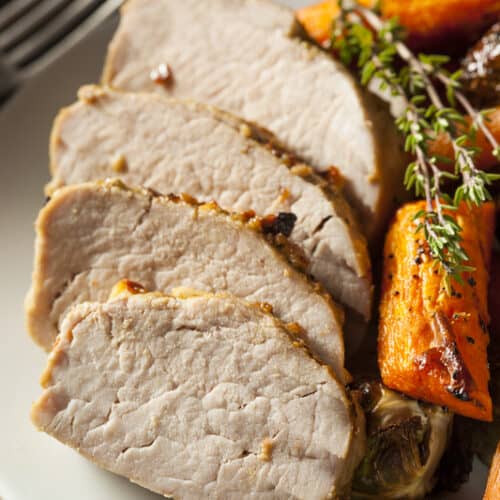
Sous Vide Pork Tenderloin
Ingredients
- 1.5 pound pork tenderloin
- 1 tablespoon avocado oil for searing
- 2 tsp salt
- ½ tsp ground black pepper
- ½ tsp garlic powder
- 2 sprigs fresh herbs optional – such as rosemary or thyme
Instructions
- Preheat the sous vide water bath to your desired temperature (130°F, 140°F, or 150°F).
- Pat the pork tenderloin dry and season generously with salt, pepper, and garlic powder. Add fresh herbs if desired.
- Place the seasoned pork tenderloin in a vacuum-sealable bag and seal it, or use the water displacement method with a freezer-safe ziplock bag.
- Submerge the sealed pork tenderloin into the preheated water bath and cook for 2 to 4 hours.
- After cooking, remove the pork tenderloin from the bag and pat it dry with paper towels.
- Heat a skillet over high heat with olive oil until smoking hot.
- Sear the pork tenderloin on all sides for 1-2 minutes until a golden-brown crust forms.
- Slice and serve immediately, or store according to the storage instructions.

